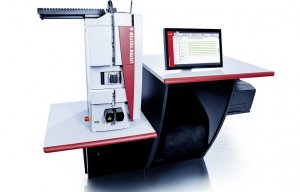
Uster Tester 6-C800 on display at Techtextil
Total transparency and accuracy in yarn count is regarded as one of the most crucial quality parameter for yarn trading and yarn processing.

12th October 2017
Innovation in Textiles
|
Uster
Total transparency and accuracy in yarn count is regarded as one of the most crucial quality parameter for yarn trading and yarn processing. Even the slightest variations in yarn count can cause serious fabric defects such as striping, ruining the finished product. Therefore, the control of this parameter is important.
Uster, a leading high-technology instrument manufacturer, has undergone detailed trials of its Sensor FA with the Uster Tester 6 at two spinning mills, in Europe and the USA, to test the accuracy of the company’s high-speed automatic measurement solution of absolute yarn count.

“The classic manual method of count measurement requires two instruments: a yarn reel and a balance. The procedure is slow, labour-intensive and subject to human error. The automatic option, using the Uster Tester 6 with the Sensor FA for automatic fineness, is fast – with testing speeds of 800 m/min,” the company explains. “It also needs only one operator and there is no risk of human error. These advantages of automatic count measurement are immense, but the accuracy of the results is the all-important issue. This was the challenge taken up at two spinning mills.”
“It is only to be expected that the test results for a crucial quality parameter, such as yarn count, will be questioned closely,” said Wolfram Soell, Textile Technologist within Uster Technologies, who executed the trial on the accuracy of the Uster Tester 6 in a spinning mill in Europe.
This customer has a reference yarn, which was tested every week for a long-term observation of the yarn count accuracy in the mill’s laboratory. The trial ran from January to August 2017, and during the first month the tests were carried out at speeds of both 400 m/min and 800 m/min. It was quickly seen that the measurement results were independent of the testing speed, so the tests continued only at 800 m/min.

During the testing period, results for the 100% combed cotton Ne 30 ring yarn showed minimal variation, according to the manufacturer. On the graph with data for the absolute count the red line indicates the insignificant variation from tex 19.82 (Ne 29.8) to tex 20.14 (Ne 29.3).
A direct comparison with the standard manual method was organised when a US customer initiated a trial after a new Uster Tester 6 installation, measuring 32 different yarns with five packages each over a four-week period.

“In a pre-test of 13 samples, the Sensor FA averaged Ne 0.1 counts heavier than the standard count determination method. When repeating the test, the average count was Ne 0.1 lighter. So overall the two methods were extremely close,” said Raul Thomas, Textile Lab and Training Manager within the Uster subsidiary based in North Carolina. Thomas was familiar with the detailed conditions in this mill and knew that data for these tests was taken from cones, as well as from bobbins. With respect to count variation, the Sensor FA had much lower variation than the standard method in almost every test, the company reports.
According to the manufacturer, all the parties involved were well satisfied with the conduct and outcome of these trials. “To Uster, it was gratifying that feedback from customers was very positive regarding the ease of use. The spinners in the trials appreciated the integration of international standards for selection of the predefined yarn length for the tests. This ensured the most accurate yarn count determination, without error-prone human interaction,” the company says.

With the Uster Tester 6, the FA measurement is carried out simultaneously with other measurements such as evenness, imperfection and hairiness. Consequently, the yarn count tests are based on a large number of measurements, giving even greater precision.

Business intelligence for the fibre, textiles and apparel industries: technologies, innovations, markets, investments, trade policy, sourcing, strategy...
Find out more